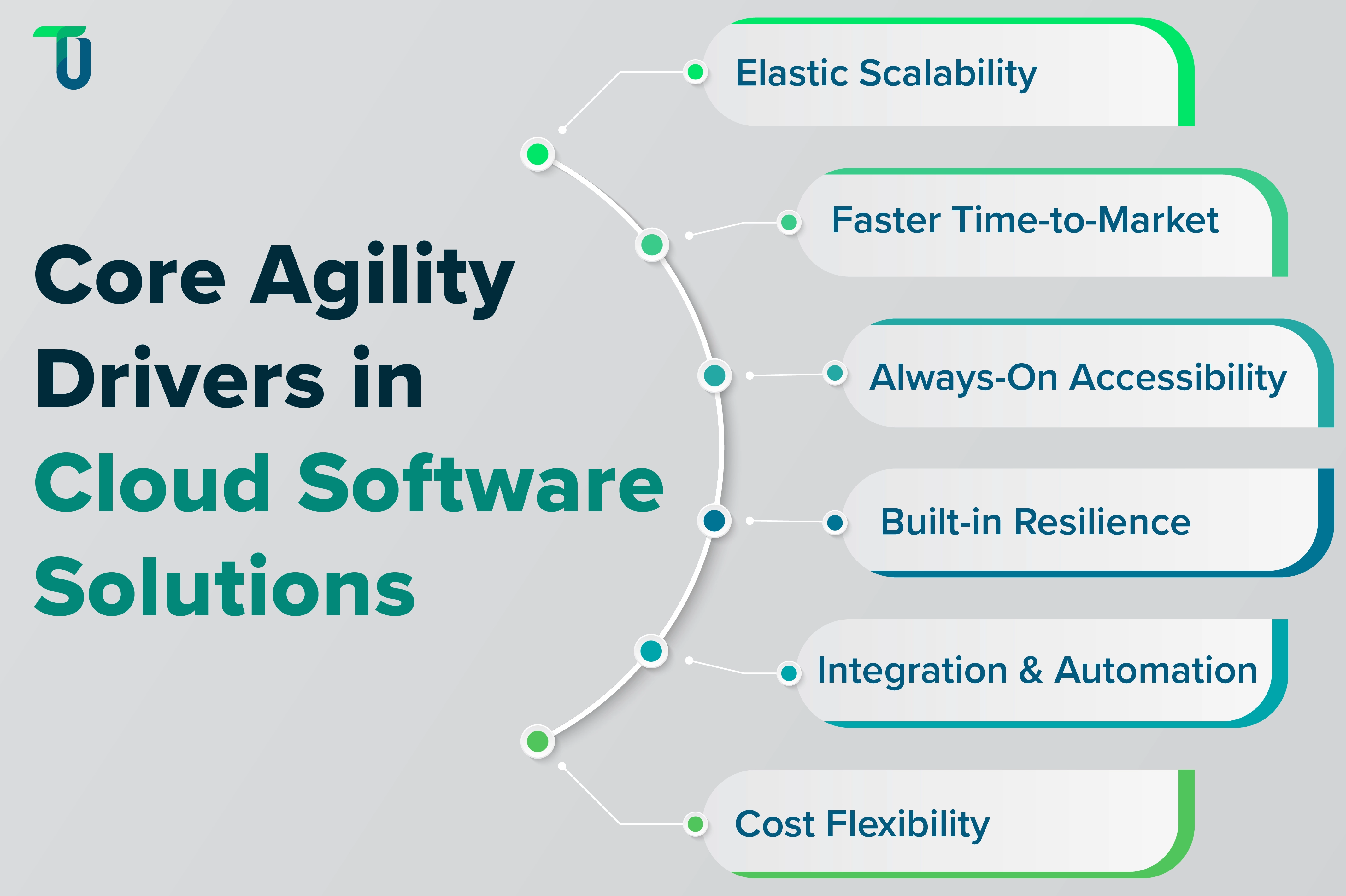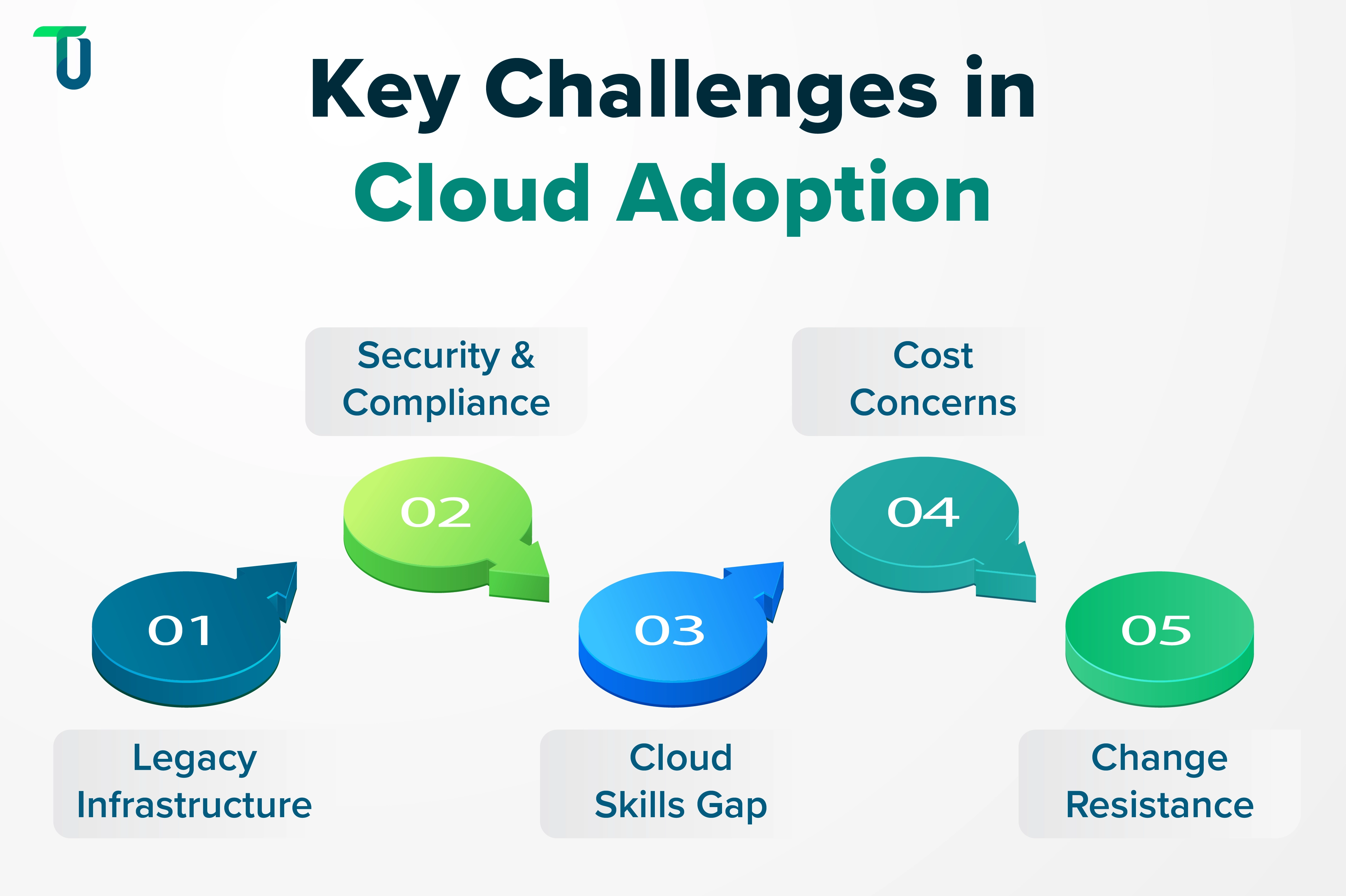Key Drivers of Agility Through Cloud Solutions
Cloud is no longer just an infrastructure upgrade—it’s a business enabler. Enterprises that embrace cloud solutions aren’t just improving their IT posture—they’re fundamentally transforming how they respond to change. Here’s how cloud drives real business agility:

1. Elastic Scalability: Adapt in Real Time
The ability to scale infrastructure and services on demand is foundational to agility. Whether it’s a seasonal spike in traffic or a sudden shift in customer behavior, cloud solutions let you respond instantly, without over-provisioning or adding complexity.
No more waiting weeks for hardware procurement. Scale up or down in minutes.
2. Faster Time-to-Market: From Ideas to Impact, Faster
Agility means speed, and cloud delivers. Pre-built services, low-code platforms, and continuous integration pipelines significantly shorten development lifecycles. Teams can prototype, test, and deploy new features faster than ever.
With cloud, innovation isn’t bottlenecked by infrastructure—it’s accelerated by it.
3. Always-On Accessibility: Work from Anywhere, Anytime
In a hybrid, remote-first world, agility hinges on access. Cloud solutions enable seamless collaboration across geographies and time zones, giving your teams the freedom to operate without disruption.
Your business doesn’t stop when your team’s offline. Cloud keeps workflows moving—securely and efficiently.
4. Built-in Resilience: Recover. Restart. Reinvent.
Cloud-native architectures are designed for failure tolerance. With automated backups, disaster recovery, and high availability built in, your business can recover quickly from disruptions without losing momentum.
Agility isn’t just about speed—it’s about staying operational no matter what.
5. Integration and Automation: Less Manual, More Momentum
Modern cloud solutions integrate effortlessly with existing systems and emerging tools. With APIs, AI/ML services, and workflow automation, you eliminate silos, reduce manual overhead, and move faster with data-driven precision.
Cloud turns scattered operations into synchronized action.
6. Cost Flexibility: Shift from CapEx to OpEx
Financial agility matters as much as operational agility. Cloud’s pay-as-you-go model means you’re no longer tied to sunk costs or rigid budgets. You spend on what you need, when you need it.
Free up capital for innovation, not maintenance.
Cloud isn’t just a tool—it’s a catalyst. These drivers don’t just enhance operations; they unlock new possibilities for how your business evolves, competes, and grows. In the next section, we’ll explore what this agility looks like in real-world scenarios.
Choosing the right cloud platform is often the first and most critical step in building agile applications. If you’re weighing options, this comparison of AWS vs Azure vs GCP for Cloud App Development breaks down what each platform offers in real-world scenarios.
Agility isn’t a future goal—it’s a now requirement.
From scaling to resilience, cloud is reshaping how leading enterprises operate. Ready to see what it can do for you?
Strategic Advantages for CTOs and CIOs
For CTOs and CIOs, agility is more than a buzzword—it’s a mandate. Your role is no longer confined to keeping the lights on. You’re steering enterprise-wide transformation, and cloud solutions give you the leverage to do it with speed, scale, and strategy.
Here’s how cloud unlocks real, measurable advantages for tech leaders:
1. Aligning IT with Business Goals—Seamlessly
Traditional infrastructure often limits how fast IT can support evolving business needs. With cloud solutions, that misalignment disappears. Cloud-native environments allow you to provision, pivot, and scale in lockstep with business priorities—be it launching new services, entering new markets, or responding to customer demands—while also delivering the crucial benefits of private cloud for compliance for regulated workloads.
IT becomes a driver of innovation, not a blocker.
2. Data-Driven Decision-Making with AI and Analytics
CTOs and CIOs are now expected to lead with insights. Cloud platforms offer built-in analytics, machine learning models, and real-time dashboards that turn raw data into actionable intelligence.
From product development to customer experience, every decision can now be backed by real-time data.
By embedding AI/ML into cloud workflows, tech leaders can automate routine tasks, detect anomalies before they escalate, and uncover patterns that drive smarter strategies.
3. Bulletproofing Business Continuity and Disaster Recovery
Downtime is costly—both financially and in terms of reputation. Cloud solutions mitigate this risk with built-in failovers, geographic redundancy, and automated backups. Whether it's a natural disaster, a cyberattack, or a simple outage, you’re covered.
Resilience is no longer optional. Cloud makes it a default setting.
For CIOs, this means stronger SLAs. For CTOs, it means fewer firefights and more time spent on innovation.
When tech leaders embrace cloud strategically, they don’t just optimize systems. They future-proof the business. From aligning tech and strategy to enabling real-time decisions and safeguarding continuity, cloud solutions offer a foundation that evolves as fast as your goals do.
Common Barriers to Cloud Adoption and Strategies to Overcome
Cloud promises speed, scale, and flexibility—but getting there isn’t always straightforward. For many enterprises, the road to cloud agility is paved with hesitation, complexity, and legacy baggage. The good news? These barriers are real, but they’re not immovable.
Here’s what typically holds organizations back—and how to move forward with confidence.

#1 Legacy Infrastructure: The Weight of “What We’ve Always Done”
Outdated on-prem systems, custom-built applications, and tangled tech stacks make cloud migration feel overwhelming.
For more on how cloud migration drives agility and security, read our post on Why Cloud Migration Services are Key for Agile & Secure Growth.
The fix: Start with a phased migration strategy. Prioritize low-risk workloads, modernize incrementally, and use hybrid cloud models to bridge the gap. Cloud isn’t all or nothing—it's about building momentum.
Pro Tip - Migrate what matters. Modernize what’s essential.
#2 Security & Compliance Concerns
For regulated industries, data sovereignty and security risks are top-of-mind,highlighting the particular benefits of private cloud for compliance . There's fear of losing control over sensitive assets.
The fix: Choose cloud providers with strong compliance frameworks, such as ISO, SOC, GDPR, and HIPAA. Implement zero-trust security models, identity governance, and encryption by default. With the proper guardrails, cloud solutions can be more secure than on-prem.
Pro Tip - Security isn’t a blocker—it’s a blueprint.
#3 Lack of Internal Cloud Expertise
Your team knows your systems, but not necessarily cloud architecture. The skill gap slows down progress and increases dependency on third parties.
The fix: Invest in upskilling. Leverage cloud training programs, certifications, and partnerships. Build cross-functional teams that combine legacy knowledge with modern cloud expertise.
Pro Tip - Agility grows when your people grow with it.
#4 Cost Uncertainty and Budget Pushback
Pay-as-you-go sounds great—until bills spike unexpectedly. CFOs worry about cost sprawl and lack of visibility.
The fix: Implement cloud cost governance from day one. Use tools for real-time cost monitoring, set budgets and alerts, and align spend with KPIs. A well-architected cloud environment is both agile and accountable.
Pro Tip - Visibility = control. Control = trust.
#5 Change Resistance Across the Organization
Cloud isn’t just a tech shift—it’s a culture shift. Resistance from stakeholders can stall or derail transformation.
The fix: Communicate the why clearly. Align cloud adoption with business outcomes, not just IT goals. Involve stakeholders early and show them quick wins that matter.
Pro Tip - Agility is as much about mindset as it is about technology.
Cloud adoption has its hurdles, but none that can’t be overcome with strategy, leadership, and the right ecosystem. For a deeper dive into selecting the right team and partner to guide this transformation, check out how to choose the right cloud development partner . In the next section, we’ll look at what agility looks like in practice, with real-world examples of cloud solutions delivering real impact.
Future Outlook: The Evolving Role of Cloud in Business Agility
Cloud has already transformed how enterprises operate—but its real potential is just getting started. As business environments grow more dynamic and unpredictable, cloud solutions will continue to evolve as the engine of agility, resilience, and innovation. Here’s what’s next.
1. Emerging Tech Will Redefine What Cloud Can Do
The next wave of cloud solutions is being shaped by AI, edge computing, and serverless architectures. These aren’t just tech buzzwords—they’re accelerators of real-time responsiveness and hyper-personalized experiences.
- AI-native cloud platforms will enable smarter decision-making at scale.
- Edge computing will reduce latency and power intelligent, localized actions.
- Serverless models will free up developers to focus on building, not maintaining.
The future of cloud isn’t just scalable. It’s intelligent, automated, and adaptive.
2. Multi-Cloud and Hybrid Are No Longer Optional
As businesses mature in their cloud journey, a single-provider strategy won’t cut it. Multi-cloud and hybrid cloud models are becoming the default, offering flexibility, risk mitigation, and better alignment with unique workload needs.
Agility means choosing the best-fit cloud for each function, not being locked into one.
CTOs and CIOs will increasingly orchestrate across platforms, optimizing for performance, cost, and compliance, while maintaining a unified governance layer.
3. Innovation Will Be Continuous, Not Cyclical
Cloud is no longer a one-time transformation project—it’s a continuous journey. Providers are rolling out new services, capabilities, and integrations at unprecedented speed. To stay agile, enterprises must adopt a cloud-as-a-product mindset—constantly evolving, iterating, and scaling.
If your cloud strategy is static, your business agility is already outdated.
This means doubling down on cloud-native practices, DevOps, FinOps, and culture change—because staying ahead isn’t just about tech, it’s about how you use it.
From Cloud-Ready to Cloud-Smart with TenUp
You’re not just trying to “keep up” anymore. You’re looking to scale smarter, move faster, and leave behind clunky, outdated systems. That’s precisely where cloud steps in—and where TenUp’ result-driven cloud solutions makes a difference.
At TenUp, we don’t just lift and shift. We help you rethink how your business runs. From strategy and modernization to application development, integration, and DevOps, we cover the full spectrum to make sure your cloud move isn’t just smooth, but worth it.
Because adopting the cloud is one thing. Using it to drive real impact? That’s the part we’re here for. Let’s take you from cloud adoption to cloud advantage. And if you're ready to lead with agility, we’re ready to build with you.
Cloud agility is more than just a shift—it’s a competitive edge.
With TenUp as your partner, unlock the potential to innovate faster, optimize smarter, and stay ahead of the curve.
Frequently asked questions
What hidden costs should businesses consider when adopting cloud software solutions?
Beyond upfront savings, cloud software solutions can incur hidden costs like data egress fees, third-party integrations, security compliance efforts, and vendor lock-in. Businesses may also face increased spending on specialized talent, migration, and ongoing optimization. Planning for these early ensures a more accurate total cost of ownership and smoother cloud adoption.
How do cloud-based solutions improve the speed of launching new products?
Cloud-based solutions accelerate product launches by offering scalable infrastructure, prebuilt tools, and automated CI/CD pipelines. They eliminate setup delays, support rapid testing and deployment, and enable global rollouts, thus cutting development time and helping businesses get to market faster.
Can small businesses benefit from business cloud solutions as much as enterprises?
Absolutely. Business cloud solutions offer small businesses scalable infrastructure, enterprise-grade tools, and automation without heavy upfront investment. These cloud-based solutions improve agility, support remote collaboration, and reduce IT maintenance costs—allowing SMEs to innovate, grow, and compete effectively with larger enterprises, all while paying only for the resources they use
What real-world examples show how cloud software solutions enable competitive advantage?
Netflix and Spotify leverage cloud software solutions to scale globally, personalize user experiences using real-time cloud data solutions, and deploy features rapidly. This agility and innovation keep them ahead in competitive markets, showcasing how cloud-based solutions drive speed, scalability, and smarter decision-making for sustained advantage.
How does cloud-based software reduce IT maintenance and operational downtime?
Cloud-based software automates updates, backups, and monitoring, handled by the provider, while reducing manual effort, minimizing downtime, and boosting reliability. It frees up internal IT teams while ensuring high availability through built-in redundancy and proactive issue detection.
What are signs that your organization needs to switch to a cloud-based solution?
Key signs include slow innovation due to outdated systems, rising IT maintenance costs, difficulty supporting remote teams, and limited scalability. If your business struggles to integrate multiple applications or faces frequent downtime, moving to a cloud-based solution can enhance flexibility, streamline operations, and foster growth by enabling better collaboration and scalability.
What common mistakes limit agility when implementing business cloud solutions?
Common pitfalls include inadequate strategic planning, neglecting security, and skipping post-migration optimization. Overreliance on a single provider, attempting large-scale migration at once, and failing to properly manage resources can all hinder flexibility and disrupt operations. A phased, strategic approach is crucial for maintaining agility and maximizing cloud benefits.
How can cloud software solutions support global expansion and market entry?
Cloud software solutions enable rapid global deployment, seamless collaboration across teams, and scalable infrastructure to meet fluctuating demands. With distributed data centers, businesses can ensure local compliance, improve performance, and expand into new markets efficiently, all while reducing costs and adapting quickly to market changes.

